PINNACLE 400 CFD
Let your profits runs, cut your losses early! Trade Pinnacle, a mechanical system designed to buy low and sell high
SHORT TERM TREND FOLLOWING!
- What is Share Trading01
- Key Features of Share Trading02
- Trade Both Long and Short03
- Calculating Profits and/or Losses04
- Share Trading Examples05
- Key Benefits of Shares06
- Margin Lending07
- Risks of Share Trading08
- Styles of Share Trading09
- Tools & Resources10
- How to Open an Account11
- Supported Brokers12
Pinnacle 400 CFD Trading System
Pinnacle 400 is a system totally executed and supervised by MyTradingAdvisor on your trading account.
Our mission is to help our clients gain exposure to the stock market, without having to do any of the heavy lifting themselves. Best part – there are no joining fees and you can have the opportunity to have a professionally built strategy executed on your account.
1. Introducing Pinnacle 400
Introducing the "Pinnacle Midcap 400" strategy by MTA, a targeted trading system developed for navigating the dynamic landscape of the S&P 400 Midcap Index through stock CFDs.
Specialising in identifying prime entry points during oversold conditions, the strategy aims for short-term gains while allowing for extended hold periods in line with prevailing market trends. Execution of the Pinnacle Midcap 400 is entirely mechanical, removing the need for discretionary judgment and enabling us to manage trade execution for our clients. This hands-off approach affords minimal day-to-day management from the client’s side, emphasizing trade monitoring and performance review.
Comprising dual entry setups, the Pinnacle Midcap 400 adapts to both uptrending and downtrending market conditions, tailoring its entries to optimize trade outcomes. Trade durations can range from one month on average for short-term components to several months or more for trend-following trades, contingent upon sustained market trends. Central to the system is a set of rigorous rules for trade entries and exits, integrating market state analysis with a focus on leveraging heavily oversold conditions as potential entry points. The strategic use of technical analysis, notably RSI and ATR indicators, is critical for pinpointing potential trades and setting precise targets for profit realization and loss prevention.
| Pinnacle 400 | Details |
|---|---|
| Minimum Investment | *US$12,500 |
| Market | S&P Midcap 400 |
| Average Trade | 3.24% |
| Average Trade Length | 6.6 Weeks |
| Percentage Winning Trades | 48.5% |
| Win:Loss Ratio | 2.15 |
- The minimum account size is based upon a five stock CFD portfolio with US$7,500 face value investment per stock for a total face value of US$37,500, which results in leverage of 3 times the suggested minimum investment amount.
2. Why the S&P Midcap 400 Stocks?
Designed for the S&P 400 Midcap Index, the Pinnacle Midcap 400 caters to traders seeking a structured, data-informed strategy for position trading, aiming at timeframes ranging from several weeks to months. Managing downside risk is a key aspect of the approach, featuring an assertive exit strategy to mitigate losses from any trades that turn adverse, underscoring the importance of protecting the trading capital. Deciding between trading stocks and stock CFDs is a pivotal consideration within the Pinnacle Midcap 400 strategy, especially given the heightened risk management required for midcap stocks, which can experience more pronounced price movements than their large-cap counterparts. Stocks might be suitable for larger accounts seeking direct exposure, whereas stock CFDs can be an attractive alternative for smaller accounts or those seeking to employ leverage to amplify their trading positions. For traders with lower capital, leveraging returns through CFDs allows for a broader engagement across the index, though it comes with the caveat of increased risk and costs due to the leveraged nature of CFD trading. Engaging with the S&P 400 Midcap stocks through the Pinnacle Midcap 400 offers several benefits:
KEY POINTS:
1
Focused Exposure:
Traders gain access to a pivotal segment of the market, representing mid-sized U.S. companies poised for growth, which often sees more significant movements than the broader market.
2
Amplified Opportunities
The midcap space frequently experiences higher volatility, providing active trading opportunities that the Pinnacle Midcap 400 is designed to exploit.
3
GROWTH POTENTIAL
The S&P 400 Midcap Index is home to companies with considerable potential for expansion and innovation, presenting opportunities for substantial returns as these companies evolve.
4
DIVERSIFICATION WITHIN HIGH GROWTH SECTORS
Despite a focus on midcap stocks, the strategy promotes diversification within this market segment to spread risk across various industries and sectors.
5
TRADING SHARE CFDs
Trading share CFDs, compared with investing, is a more hands-on activity with daily or weekly monitoring of your account, which involves buying and selling with the aim to capitalize on shorter-term fluctuations. The purpose of trading is to generate income to supplement a primary source of income with the possible secondary goal of perhaps one-day trading for a living.
6
ADAPTABILITY TO MARKET TRENDS
The index is periodically reviewed and adjusted, ensuring it remains reflective of the leading non-financial companies on the Midcap index. This adaptability means that the Midcap 400 evolves with the market, incorporating emerging leaders and shedding companies that fall behind, providing traders with a vehicle that aligns with current and emerging market trends.
3. Strategic Considerations
When it comes to the Pinnacle Midcap 400 CFD strategy, strategic considerations are vital for optimizing trades within the dynamic realm of midcap stocks. The Midcap 400, comprising a diverse array of companies, presents unique opportunities distinct from larger indices like the S&P 500. These companies are often in their growth phase, offering the potential for significant returns. However, this comes with inherent volatility that the Pinnacle Midcap 400 strategy is designed to navigate. The strategy prioritizes identifying strong momentum and growth trends among these mid-sized companies, leveraging technical analysis to determine optimal entry and exit points, aiming to capture growth while managing the higher volatility characteristic of the midcap sector.
A cornerstone of the Pinnacle Midcap 400 strategy is its focus on managing risk through meticulous analysis and a disciplined trading framework. In a market segment where individual stock movements can be more pronounced, the system emphasises a robust risk management protocol, including carefully calibrated stop-loss settings and position sizing. This ensures that while the strategy takes advantage of the growth trajectory of midcap companies, it also keeps potential risks in check, maintaining a balance between aggressive pursuit of returns and the preservation of capital. The strategic use of CFDs allows for flexible position sizing and can enhance portfolio diversification, however leveraging the overall risk exposure still provides significant exposure to potential gains and losses.

Moreover, the Pinnacle Midcap 400 strategy incorporates a hold for longer approach to winning trades if the market timing is spot on, which is especially pertinent in the midcap space, where stocks can trend significantly. These companies may respond differently to market cycles compared to their large-cap counterparts, often due to their specific industry, growth stage, or even regulatory environment. The strategy takes a measured approach, adjusting to market conditions with the agility required for the midcap environment. For investors, this means engaging with a strategy that is both sophisticated in its analysis and strategic in its execution, tailored to the unique landscape of the S&P Midcap 400.
4. What is the Pinnacle 400 Strategy:
The Pinnacle 400 strategy is a disciplined CFD trading system designed specifically for the S&P Midcap 400, targeting companies poised for growth. It utilizes advanced technical analysis to pinpoint entry and exit points, capitalizing on the distinctive volatility and growth potential of mid-sized companies. With an emphasis on risk management and strategic leverage, the Pinnacle 400 system aims to maximize returns while navigating the unique opportunities and challenges presented by the midcap market.
DATA INFO:
The strategy uses data from the S&P Midcap 400 market, analysing both daily and weekly price movements of stocks within this index.
5. The Rules
The strategy consists of several rules for deciding when to buy (enter) or sell (exit) stocks. These rules are based on technical indicators, primarily focusing on the Average True Range indicator (ATR) and the Relative Strength Indicator (RSI).
- Bull Market Entry: This rule identifies buying opportunities within an uptrend when the market is temporarily oversold. It relies on the four period RSI falling below a lower thresold, to signal when prices have fallen to a level that may be considered oversold, whilst the stock remains in a longer-term uptrend defined by the lower Keltner band offering a strategic entry point for traders to capitalise on the resumption of the uptrend.
- Bear Market Entry: This rule triggers a buy signal when the closing price has been heavily sold off. It leverages the concept of countertrend trading, where entering the market during a sell-off can at times result in an entry at the beginning of a new bullish trend. This strategy comes into play when the closing price is below the lower Keltner Band when both the four period weekly RSI and four period daily RSI is below a lower threshold.
- Stop Loss: The stop loss for this system initiates when the lowest low in the trades is more than 3% from entry. If this condition is triggered, we set a target price at the lowest point in the trade plus 1.5 times Average True Range. When the close finishes above this level we exit on the following days open.
- Profit Target: This rule sets a target price to sell and take profits, calculated as the lowest price during the trade plus a multiple of average true range (ATR).

6. How it Works in Practice
Remember, while strategies like Pinnacle 400 can provide great trade setups, they're not foolproof. Market conditions can at times be unfavorable, and risk management is crucial. Always be prepared for the possibility of loss.
IDENTIFY OPPORTUNITY
Use the rules to find stocks that have hit a low point according to the strategy’s criteria.
ENTER THE TRADE:
Buy the stock when it meets the entry conditions.
SET PROFIT TARGET
Know in advance what the profit target is, based on the strategy’s profit target rule.
EXIT STRATEGY:
Sell the stock when it reaches the profit target or if any conditions suggest it’s time to exit to minimise losses.
LEVERAGE IS OPTIONAL
OUTSOURCE YOUR TRADE EXECUTION
This strategy is fully mechanical which allows you to outsource the management of the strategy on your account to MyTradingAdvisor. MTA will monitor the system on a day to day basis and execute the orders for the system on your account according to the terms and condition in the Strategy Execution Document.
7. Risk Management
A robust risk management framework is intrinsic to the Pinnacle Midcap 400, tailored to the unique characteristics of midcap trading. Recognising the increased volatility and growth prospects of midcap stocks, the strategy includes:
- Calibrated Trade Sizing: Determining appropriate position sizes to balance potential returns against risk exposure, especially crucial in the midcap market where price swings can be more pronounced.
- Dynamic Leverage Management: Using leverage judiciously, in line with a trader’s risk profile and market conditions, to optimise the risk-reward ratio of the trading strategy.
- Technical Analysis for Entry/Exit: Employing RSI and ATR as primary tools to gauge market sentiment and price trends, ensuring that entries and exits are timed to capitalize on the market’s natural ebb and flow.
- Diversification: We suggest a portfolio size of 5-20 stock CFDs.
Our service encompasses complete execution and supervision of the Pinnacle Midcap 400 strategy for our clients, offering a specialized approach to the midcap segment that leverages opportunities for gain while prioritizing the protection of investments. This client-centric management includes educating traders on the nuances of midcap CFD trading and providing transparent reporting on all executed trades and strategy performance.
8. Strategy Statistics
The performance summary for the Pinnacle 400 trading system provides a comprehensive review of its efficacy across the S&P Midcap 400 stock constituents as of the 28th of February 2024. Key indicators such as winning percentage, average profit per trade, and payout ratio are highlighted to assess the strategy's success. This report offers a consolidated view of the trading outcomes from all executed trades, serving as a valuable tool for understanding the system's average profitability per trade and informing decisions on risk allocation for future trades. It's a strategic analysis designed to quantify performance and refine the risk management approach within the midcap market.
In practice it would not be possible to take every single trade across all stocks as most accounts would not be large enough to handle more than 10-20 open trades at any one time, and as such numbers need to be analysed in this context.
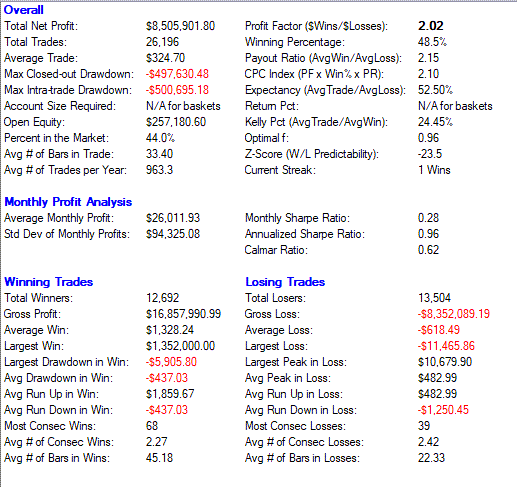
Closed Trade Equity Curve
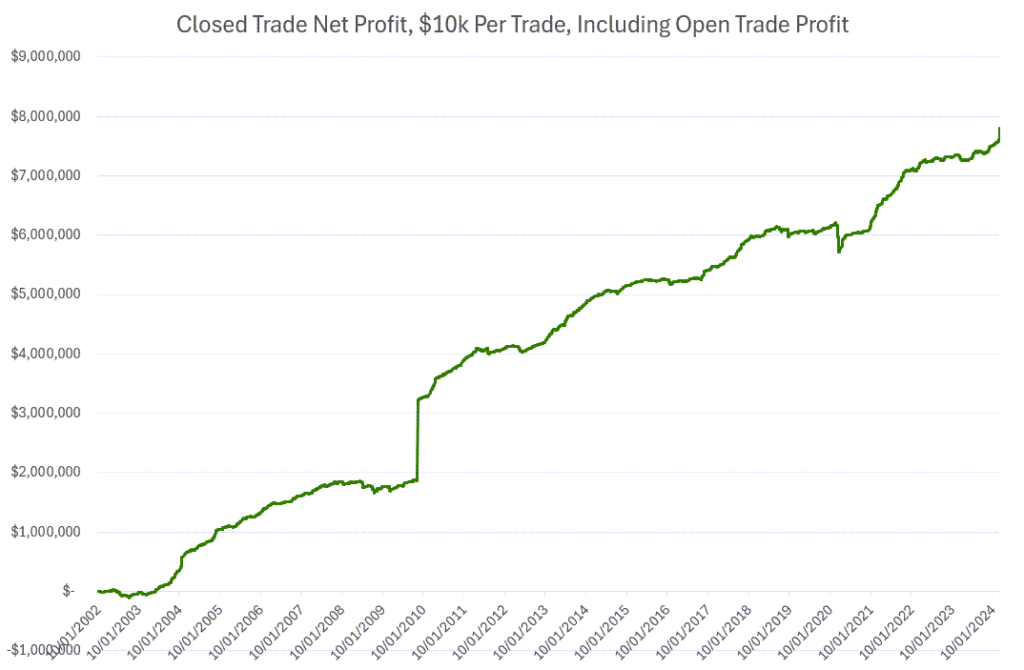
The closed trade equity curve show the results for the Pinnacle 100 system rules if traded with a fixed US$10,000 per trade from January 1, 2002, to February 19, 2024, on the stocks in the S&P 500 Index as at 28th February 2024.
OVERALL PERFORMANCE
- Assumptions: Trade Size: $10,000 per trade. All figures in USD.
- Number of Trades: All trades taken across all 400 stocks.
- Date Frame: 1st January 2002-29th February 2024.
- Total Net Profit: The strategy has generated $8,505,901.80, indicating the overall profitability after accounting for all gains and losses.
- Total Trades: The number of trades executed, 26,196, reflecting the strategy’s level of activity.
- Average Trade: The average profit or loss per trade is $324.70, showing what is typically gained or lost on each trade.
- Max Closed-out Drawdown: The largest loss from peak to trough in the strategy’s history is -$497,630.48, indicating the maximum reduction in account value due to a series of losses.
- Max Intra-trade Drawdown: The biggest loss experienced within a single trade before it was closed is -$500,759.18, highlighting the maximum unrealized loss on open positions.
- Open Equity: The profit or loss on open positions not yet closed is $237,715.46, reflecting potential future gains or losses.
- Percent in the Market: At 44.0%, this shows the proportion of time the strategy is actively trading in the market.
- Avg # of Bars in Trade: Trades last an average of 43.70 price bars, indicating the typical duration of a trade.
MONTHLY PROFIT ANALYSIS
- Average Monthly Profit: The strategy earns an average of $26,011.93 per month.
- Std Dev of Monthly Profits: The standard deviation of $94,325.08 indicates variability in monthly profit amounts.
WINNING VS. LOSING TRADES
Winning Trades
- Total Winners: A total of 12,692 winning trades.
- Gross Profit: The total profit from these winning trades is $16,857,990.99.
- Average Win: The average winning trade nets $1,328.24.
- Avg # of Bars in Wins: Winning trades are held for an average of 45.18 price bars.
Losing Trades
- Total Losers: There are 13,504 losing trades in total.
- Gross Loss: The total amount lost on these trades is -$8,352,089.19.
- Average Loss: The average losing trade has a loss of -$618.49.
- Avg # of Bars in Losses: Losing trades are held for an average of 22.33 price bars.
RISK METRICS
Utilizing the Pinnacle 400 trading system, the following key performance metrics provide insight into its efficacy within the S&P Midcap 400:
- Profit Factor (Wins/Losses): At 2.02, this metric indicates that for every dollar lost, two dollars and two cents were earned, showcasing the system’s efficiency in generating profits over losses.
- Winning Percentage: With 48.5% of trades yielding profit, this percentage reflects a near-balanced distribution of winning and losing trades within the strategy.
- Payout Ratio (Avg Win/Avg Loss): An average win to average loss ratio of 2.15 signifies that wins are, on average, more than twice as large as losses, illustrating the system’s ability to capture significant gains.
- Kelly Pct (Avg Trade/Avg Win): The Kelly criterion suggests using 24% of capital per trade, which is a formula used to maximize the long-term growth rate of repeated plays of a game of chance.
- Optimal f: Valued at 0.36, this metric is used to determine the optimal fraction of capital to wager on a given trade.
- Monthly Sharpe Ratio: With a value of 0.28, it indicates that the investment’s return is 0.28 times the standard deviation above the risk-free rate on a monthly basis, which helps assess the risk-adjusted performance.
- Annualized Sharpe Ratio: At 0.96, this annualized figure suggests that the strategy’s returns are nearly equal to the risk taken over the course of a year.
- Calmar Ratio: The value of 0.62 reflects the relationship between the annual rate of return and the maximum drawdown, indicating that for each unit of risk, there’s a return of 0.62 units.
These ratios collectively provide a nuanced understanding of the Pinnacle 400 strategy’s performance, revealing how returns measure up against associated risks and the depth of drawdowns, crucial for investors assessing potential downside exposure.
SUMMARY
An analysis of the equity curve for this strategy shows it performs strongly in bull markets but does not lose heavily in bear markets. The periods from 2000-2003, 2007-2009 and 2021 to 2022 are periods where markets were in bear market territory.
9. Examples
Trade Example#1 – Applied Materials (AMAT)
Trade #1
- Entry on the 27th of December 2022 at $95.14
- Exit on 13th of October 2023 at $146.49
- Result: Profit of $51.35 or 53.9%
Trade #2
- Entry on the 24th of October 2023 at $134.81
- Exit on the 2nd of November 2023 at $137.28
- Result: Profit of $2.47 or 1.83%
Trade #3
- Entry on the 7th of December 2024 at $146.71
- Current Position trading at $209.49 as at 4th March 2024
- Result: Open trade profit of $62.78 or 42.79%
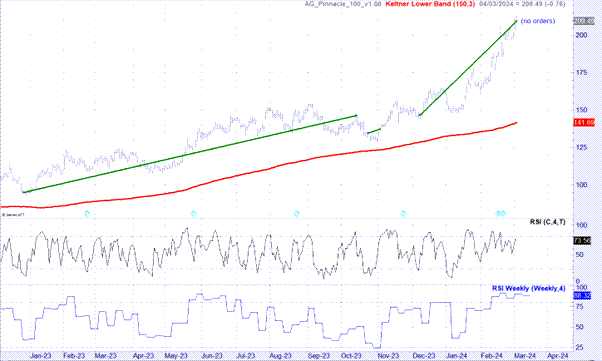
Trade Example#2 – Astra Zeneca (AZN)
Trade #1
- Entry on the 21st of August 2023 at $67.96
- Exit on the 11th of September 2023 at $64.98
- Result: Loss of $2.98 or 4.38%
Trade #2
- Entry on the 23rd October 2023 at $61.90
- Exit on the 13th February 2024 at $60.34
- Result: Loss of $1.56 or 2.52%
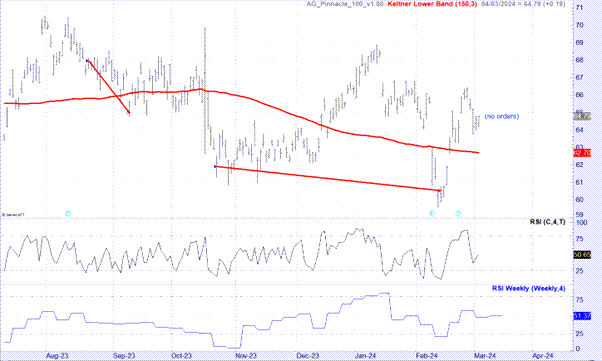
Trade Example#3 – Booking Holdings (BKNG)
Trade #1
- Entry on the 8th of December 2023 at $1962.39
- Exit on the 19th of May 2023 at $2780.97
- Result: Profit of $818.58 or 41.7%
Trade #2
- Entry on the 31st of May 2023 at $2516.77
- Exit on the 11th of December 2023 at $3287.65
- Result: Profit of $770.88 or 30.6%
Trade #3
- Entry on the 4th of January 2024 at $3400
- Current price as at 4th March 2024 $3461.79
- Open position profit of $61.79 or 1.8%
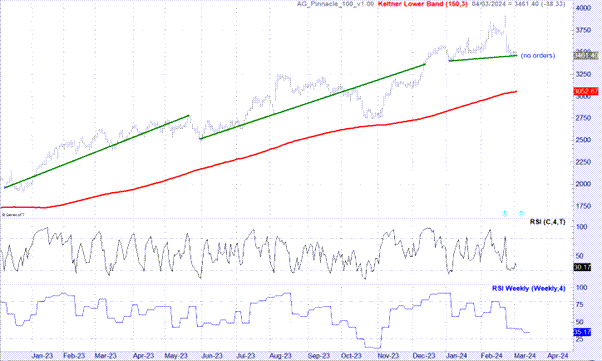
Trade Example#4 – Charter Communications (CHTR)
Trade #1
- Entry on the 23rd of August 2023 at $416.31
- Exit on the 1st of November 2023 at $402.85
- Result: Loss of $13.46 or -3.23%
Trade #2
- Entry on the11th of December 2023 at $372.59
- Exit on the 22nd of January 2023 at $371.10
- Result: Loss of $1.49 or -0.4%
Trade #3
- Entry on the 5th February 2024 at $316.11
- Exit on the 16th of February 2024 at $295.40
- Loss of $20.71 or -6.55%
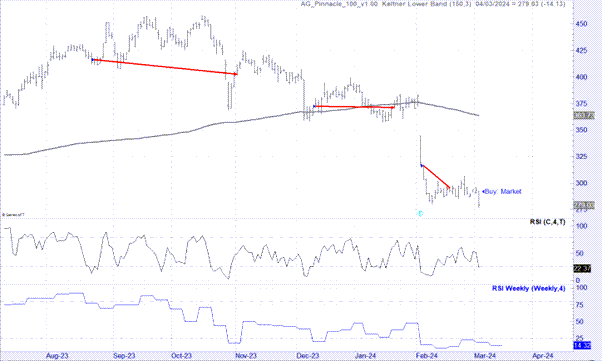
Trade Example#5 – CoStar Group (CSGP)
Trade #1
- Entry on the 13th of March 2023 at $66.85
- Exit on the 22nd of June 2023 at $87.35
- Result: Profit of $20.50 or 30.66%
Trade #2
- Entry on the 31st of July 2023 at $81.83
- Exit on the 24th of August 2023 at $80.78
- Result: Loss of $1.05 or 1.28%
Trade #3
- Entry on the 14th of September 2023 at $81.33
- Exit on the 21st of September 2023 at $80.50
- Result: Loss of -$0.83 or -1.02%
Trade #4
- Entry on the 3rd of October 2023 at $76.09
- Exit on the 1st of November 2023 at $73.38
- Result: Loss of $2.71 or -3.56%
Trade #5
- Entry on the 3rd of January 2024 at $85.25
- Exit on the 10th of January 2024 at $83.24
- Result: Loss of -$2.35 or -2.75%
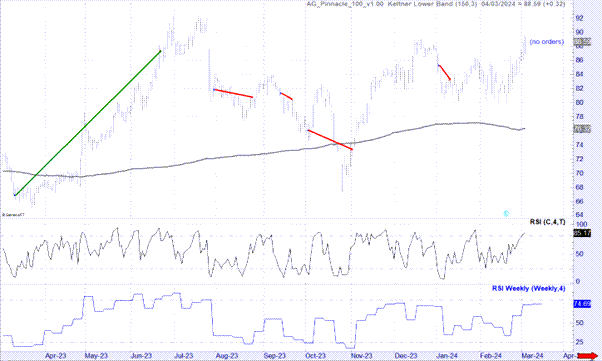
TO PROCEED CLICK "SIGN UP NOW"
The Pinnacle 400 Strategy is a robust system, with the rules showing a strong historical positive expectancy. For traders seeking to amplify their investment portfolios this strategy is particularly enticing due to its strong performance metrics.
Investors interested in a disciplined and tested approach to trading, with clear historical evidence of success, should consider the Pinnacle 400 Strategy as a compelling option for their short-term trading endeavours. It’s an opportunity to participate in a robust strategy that has the potential to demonstrate resilience and profitability over time.
To have this strategy executed for you on your trading account please select the ‘Sign Up Now” button below to proceed. On the next page you will be asked for your name, email and phone number. We will check to see if you have an existing account, if so we will send you our Strategy Execution Agreement. If not we will help you to open an account with Interactive Brokers, which will be linked to MTA so we are able to execute trade on your account once funded.
